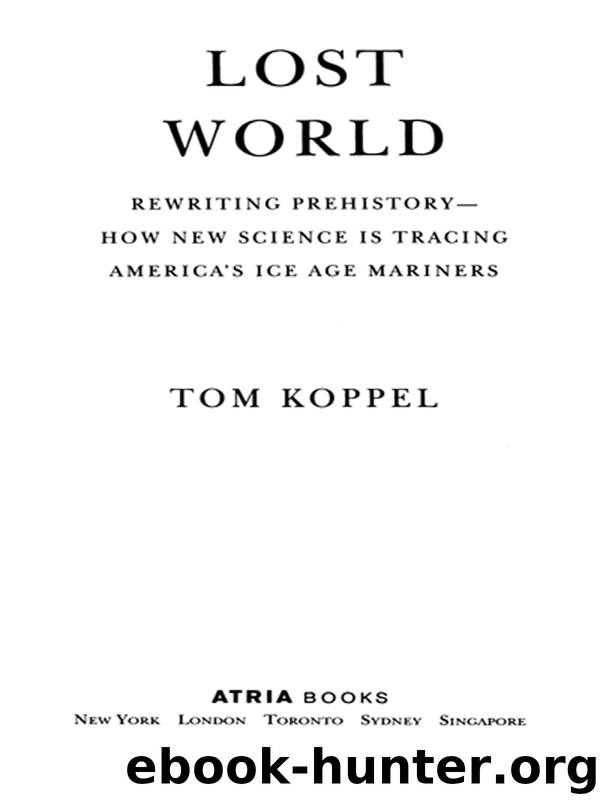Lost World by Tom Koppel

Author:Tom Koppel
Language: eng
Format: epub
Publisher: Atria Books
As with genetics, some linguists have tried to use language evolution as a ticking clock to estimate how long people have been in the New World. Languages evolve over time much like biological species, diversifying, branching off like the limbs of a tree, and becoming increasingly distinct. Johanna Nichols of the University of California at Berkeley looked at the linguistic diversity of pre-Columbian America. Finding that the Americas had about the same amount of linguistic diversity as Australia and New Guinea, which have been inhabited for 40,000 to 50,000 years, she began to suspect that the New World must, therefore, have been populated for about as long as those territories. In any case, she was certain that the amount of linguistic diversity in the Americas could not be accounted for in the 12,000 or so years allowed by Clovis First.
Then she spent years crunching numbers. She found about 150 language families in the Americas. Looking at the rate of language divergence in places like New Guinea, where the time of first occupation is relatively well determined, she found that each language family could be expected to engender one and one-half to two new language families about every 6000 years. Assuming two or three waves of migration, she factored in this rate of language evolution and concluded that the first wave or two of migrants likely arrived from Asia 30,000 to 50,000 years ago.
As with conclusions based on estimated rates of genetic mutation, though, there was no control on this experiment, no way to verify that the rate of language diversification in the Americas has actually followed the pattern set elsewhere. If for any reason the assumed rate was off by a significant factor, all the calculations were out the window. The long chronology remained hypothetical.
A very different type of linguistic argument was made by Richard A. Rogers, a geographer formerly at the universities of Nebraska and Kansas and later at the U.S. Department of Agriculture. Personally, I found it far more compelling.
A basic principle of linguistics asserts that the diversity of languages in an area reflects the length of time those languages have been there. As Rogers told one academic symposium, “as languages diversify, the longer they were in a geographical area, the more diverse they would become.” If you look at the geographic range covered by a group of related languages, therefore, “the area that shows the greatest diversity has a very high probability of being their homeland.” What’s more, as the languages diverge further, language groups arise that do not seem to be related to other language groups in the vicinity. This means that any region with a tight clustering of many seemingly unrelated languages is probably an area that has been populated for a very long time. By contrast, any geographic region that has only one or a few languages, and where they are spread out over a large area, has likely been populated relatively recently.
There was no denying his highly original insight. The geographic clustering was
Download
This site does not store any files on its server. We only index and link to content provided by other sites. Please contact the content providers to delete copyright contents if any and email us, we'll remove relevant links or contents immediately.
| Africa | Americas |
| Arctic & Antarctica | Asia |
| Australia & Oceania | Europe |
| Middle East | Russia |
| United States | World |
| Ancient Civilizations | Military |
| Historical Study & Educational Resources |
The Daily Stoic by Holiday Ryan & Hanselman Stephen(3208)
The Fate of Rome: Climate, Disease, and the End of an Empire (The Princeton History of the Ancient World) by Kyle Harper(2984)
People of the Earth: An Introduction to World Prehistory by Dr. Brian Fagan & Nadia Durrani(2682)
Ancient Worlds by Michael Scott(2601)
Babylon's Ark by Lawrence Anthony(2512)
The Daily Stoic by Ryan Holiday & Stephen Hanselman(2435)
Foreign Devils on the Silk Road: The Search for the Lost Treasures of Central Asia by Peter Hopkirk(2414)
India's Ancient Past by R.S. Sharma(2380)
MOSES THE EGYPTIAN by Jan Assmann(2355)
The Complete Dead Sea Scrolls in English (7th Edition) (Penguin Classics) by Geza Vermes(2213)
Lost Technologies of Ancient Egypt by Christopher Dunn(2181)
The Earth Chronicles Handbook by Zecharia Sitchin(2160)
24 Hours in Ancient Rome by Philip Matyszak(2034)
Alexander the Great by Philip Freeman(2017)
Aztec by Gary Jennings(1942)
The Nine Waves of Creation by Carl Johan Calleman(1853)
Curse Tablets and Binding Spells from the Ancient World by Gager John G.;(1825)
Before Atlantis by Frank Joseph(1793)
Earthmare: The Lost Book of Wars by Cergat(1770)
